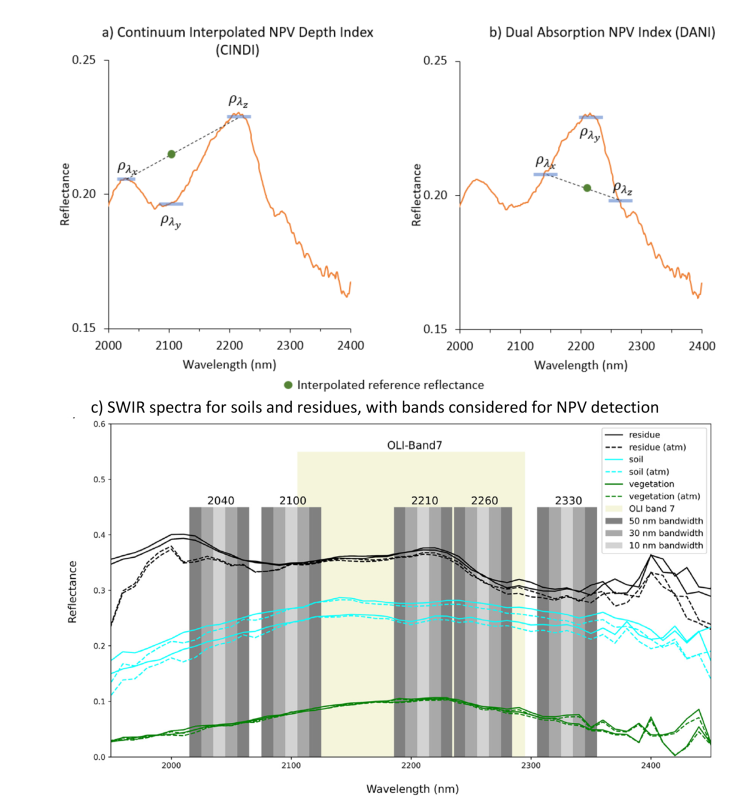Non-photosynthetic vegetation (NPV) is plant material that has no photosynthetic function, such as dead biomass, surface litter, and woody stems. NPV serves an ecologically beneficial role; in the agricultural setting, maintaining crop residue on the soil surface reduces erosion, improves soil structure, maintains stable temperatures, and increases soil carbon, all of which support the health of farming systems. Measurement of NPV is thus important for monitoring land use and conservation impacts in forest, rangeland, and cropland environments. However, options for regional-scale satellite remote sensing of NPV are currently limited to broad spectral indices that show substantial interference from soil moisture and green vegetation. There is interest in improving global capacity for NPV detection by including several narrow spectral bands in the shortwave infrared (SWIR) wavelengths on the Landsat Next satellite mission, which is expected to launch in late 2030. Determination of the best spectral solutions for NPV detection is therefore a priority.
U.S. Geological Survey scientists are collaborating with the National Aeronautics and Space Administration, the U.S. Department of Agriculture – Agricultural Research Service, and the University of Utah to derive specifications for narrow-band SWIR indices optimized for measurement of NPV, with a main focus on crop residue. The team uses field-collected hyperspectral data to simulate multispectral indices for targets exhibiting a range of residue cover, soil cover, green vegetation, and moisture conditions. In a published manuscript, researchers evaluated narrow heritage SWIR bands used on the ASTER and WorldView-3 satellites and found optimum solutions for three-band and two-band SWIR indices using a dataset of 916 samples collected in Beltsville, Maryland. Another study used the same dataset to finely tune band center placement and to consider secondary indices to account for moisture conditions.
A third study is expanding analysis to a spectral library of global soils, employing spectral mixing and calculation of atmospheric effects to assess band width and placement for SWIR NPV indices that meet Landsat Next mission requirements. Results show substantial improvement over present capability. The use of a 3-band Cellulose Absorption Index centered at 2038, 2105, and 2210 nanometers maximized accuracy in measuring NPV cover, while minimizing interference from atmosphere, moisture, soil absorptions, and green vegetative cover. Results have been communicated to the Landsat Next mission team, as well as to Sentinel-2 Next Generation mission planners from the European Space Agency. It is hoped that the many advances planned for the Landsat Next satellites will result in a robust capacity for global measurement of crop residue cover, which will provide tools for improved management of sustainable landscapes.

Example spectra of non-photosynthetic vegetation (NPV) in the shortwave infrared (SWIR) region showing generalized index calculation (a, b) to characterize lignocellulose absorption features and comparing NPV spectra to soil and green vegetation (c). Currently, Landsat 8 and 9 contain only one broad band in the SWIR region and are not capable of measuring lignocellulose absorption (c). The associated manuscript is available here.
Disclaimer: Any use of trade, firm, or product names is for descriptive purposes only and does not imply endorsement by the U.S. Government.

